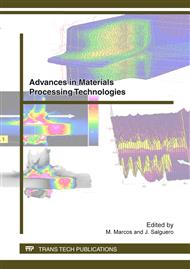p.115
p.121
p.127
p.133
p.139
p.145
p.151
p.157
p.163
Improvement of the Mechanical Properties of Formed Steel Cross Section Profile for Timber Upgrading
Abstract:
The main objective of this paper is to analyze the behaviour of cold formed steel cross section respect to mechanical characteristics, such as deflection, mainly. A cold formed steel profile with thickness of 1 mm regards is studied to determine its viability as reinforcement of timber upgrading. Thus, temperatures, stresses and strains have been analysed during the manufacturing process of these profiles, and also, the deflection supported, comparing between unreinforced and reinforce pieces. The analysis has been carried out by means of Finite Element Method, using DEFORM 2D software, during the simulation of manufacturing process and COPRA software during the final static computations. Results provide information about the integrity and good behavior of these profiles for timber upgrading.
Info:
Periodical:
Pages:
139-144
Citation:
Online since:
April 2012
Authors:
Price:
Сopyright:
© 2012 Trans Tech Publications Ltd. All Rights Reserved
Share:
Citation:


